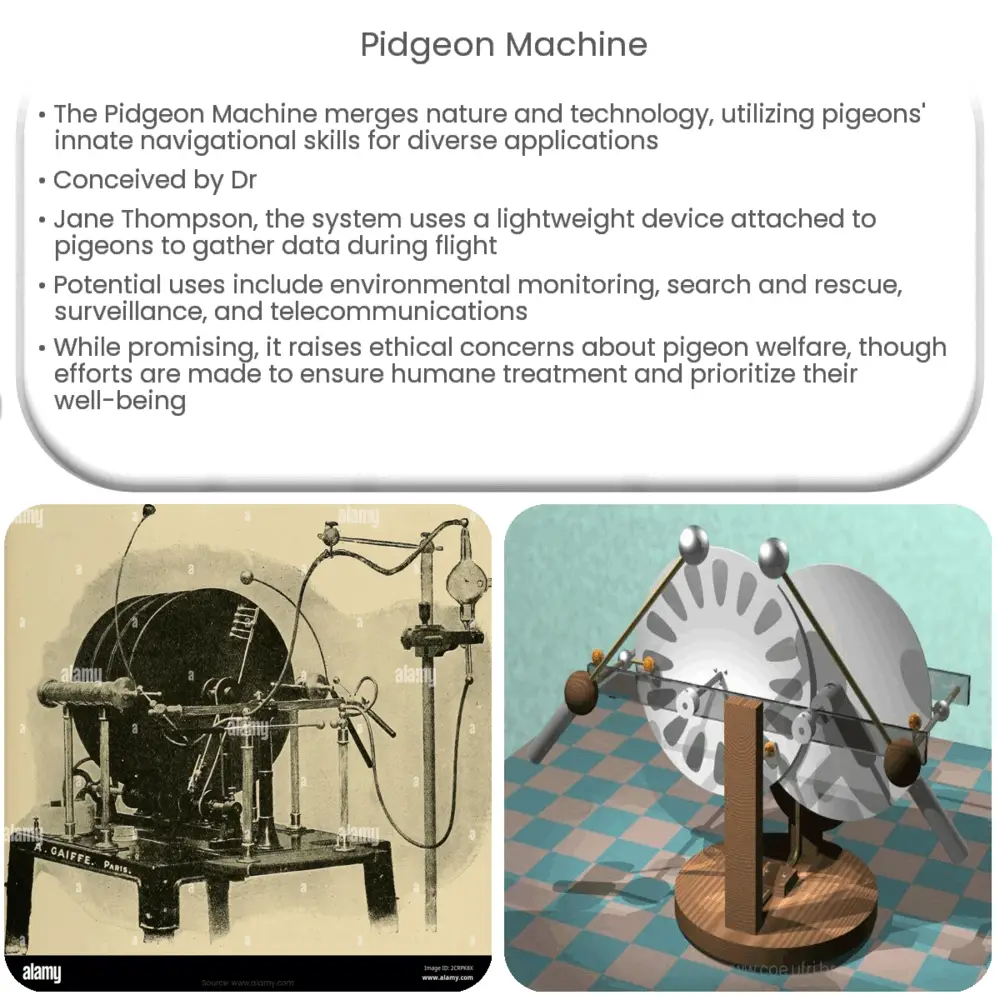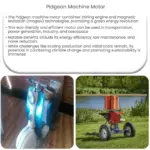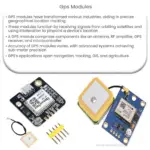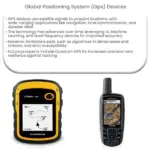The Pidgeon Machine utilizes pigeons’ innate navigational skills, GPS, and micro-cameras for environmental monitoring, search & rescue, and communication applications.

The Pidgeon Machine: Combining Nature and Technology
As our society grows increasingly dependent on technology, the combination of nature and artificial intelligence is becoming more and more important. The Pidgeon Machine is one such example that has captured the attention of researchers and enthusiasts alike. This innovative system, which harnesses the natural abilities of pigeons for use in various applications, has the potential to revolutionize a wide range of industries.
Overview of the Pidgeon Machine
The Pidgeon Machine is a cutting-edge technology that utilizes the innate navigational and communication skills of pigeons. The idea was first conceptualized by Dr. Jane Thompson, a renowned ornithologist and engineer. She was inspired by the historical use of homing pigeons for communication and the incredible accuracy of their navigational capabilities.
Dr. Thompson and her team developed a lightweight, unobtrusive device that can be safely attached to a pigeon’s body. The device is equipped with GPS, micro-cameras, and sensors that allow it to gather valuable information during the bird’s flight. This information is then transmitted to a central control system where it can be analyzed and utilized for various purposes.
Applications of the Pidgeon Machine
The Pidgeon Machine has numerous potential applications, ranging from scientific research to disaster relief. Some of the most promising uses include:
- Environmental monitoring: The ability to gather data from hard-to-reach or inhospitable environments makes the Pidgeon Machine an ideal tool for monitoring the health of ecosystems, tracking wildlife populations, and studying climate change.
- Search and rescue: Equipped with high-resolution cameras and GPS technology, the Pidgeon Machine can assist in locating missing persons or survivors of natural disasters.
- Surveillance and reconnaissance: The Pidgeon Machine can be deployed in situations where traditional surveillance methods are impractical or too risky, such as monitoring hostile territories or tracking criminal activities.
- Telecommunications: The Pidgeon Machine’s ability to relay information across long distances without the need for traditional infrastructure makes it an innovative solution for establishing communication networks in remote or disaster-stricken areas.
Challenges and Ethical Considerations
Despite its numerous potential applications, the Pidgeon Machine also presents some challenges and ethical concerns. The primary concern is the welfare of the pigeons themselves. Critics argue that using these birds for human purposes could expose them to unnecessary risks and compromise their natural behaviors. Dr. Thompson and her team have been diligent in addressing these concerns, developing a device that minimizes potential harm and ensuring that the birds are treated ethically and humanely.
Other challenges include regulatory hurdles, potential interference with other avian species, and the risk of technological malfunctions. As research on the Pidgeon Machine continues, it will be crucial for scientists and engineers to address these concerns in order to fully realize the potential of this groundbreaking technology.
Advancements in Pigeon Training and Welfare
In response to concerns about pigeon welfare, researchers have developed innovative training methods to minimize the impact on the birds’ natural behaviors. One such approach involves using positive reinforcement to encourage pigeons to adapt to the Pidgeon Machine and participate in the designated tasks. Additionally, regular health assessments and strict guidelines for rest and recuperation periods are implemented to ensure the birds’ wellbeing is prioritized.
Moreover, the devices themselves are designed to be as lightweight and unobtrusive as possible to minimize any potential discomfort for the pigeons. Advances in miniaturization and materials engineering have allowed the development of devices that can be safely attached without hindering the bird’s ability to fly or engage in natural behaviors.
Collaboration with Conservation Efforts
Recognizing the potential impact of the Pidgeon Machine on wildlife conservation, several environmental organizations have partnered with Dr. Thompson’s team to explore ways to leverage the technology for the greater good. By utilizing the Pidgeon Machine for monitoring endangered bird species, tracking migration patterns, and assessing habitat changes, researchers hope to gather valuable data that can inform conservation strategies and contribute to the preservation of various ecosystems.
Future Prospects and Developments
As the Pidgeon Machine continues to evolve, researchers are looking into expanding its capabilities and potential applications. Some of the future developments being explored include:
- Integration with drone technology: Combining the Pidgeon Machine with drone capabilities could allow for even greater control and versatility in data gathering and communication tasks.
- Machine learning algorithms: Implementing artificial intelligence to analyze the data collected by the Pidgeon Machine could enhance the system’s overall effectiveness and efficiency, as well as enable the identification of patterns and trends that might otherwise go unnoticed.
- Inter-species collaboration: Investigating the possibility of using other bird species with unique abilities, such as the swift or albatross, could expand the range of applications and increase the potential benefits of the technology.
Conclusion
The Pidgeon Machine represents a unique fusion of nature and technology, with the potential to revolutionize a diverse array of industries. As researchers continue to refine the technology and address the challenges and ethical concerns associated with its use, the Pidgeon Machine stands as a testament to the power of innovation and the limitless possibilities that can be achieved through the collaborative efforts of humans and the natural world.




